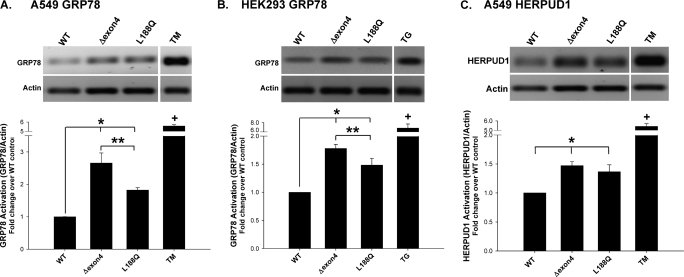Figure 1.
Unfolded protein response (UPR) gene induction in surfactant protein C (SP-C) BRICHOS mutant–expressing cells. A549 and human embryonic kidney epithelial (HEK293) cells, transiently transfected with EGFP–SP-C wild-type (WT), Δexon4, or L188Q constructs, were harvested 48 hours after transfection, and total RNA was prepared. Overnight treatments of 2 μM thapsigargin (TG) or 20 μg/ml tunicamycin (TM) were used for positive control samples. RT-PCR was performed with primers for GRP78/BiP (A and B) and homocysteine-inducible, endoplasmic reticulum stress–inducible, ubiquitin-like domain member 1 (HERPUD1) (C) expression, as described in Materials and Methods. Band intensities were quantified by densitometry, and the ratio of either GRP78 or HERPUD1 to β-actin was determined. Data are expressed as fold change over WT control samples, and represent the mean ± SD of three separate experiments. Representative agarose gels appear above each graph. *P < 0.05 versus WT control. **P < 0.05 versus Δexon4. +P < 0.001 versus WT control.

